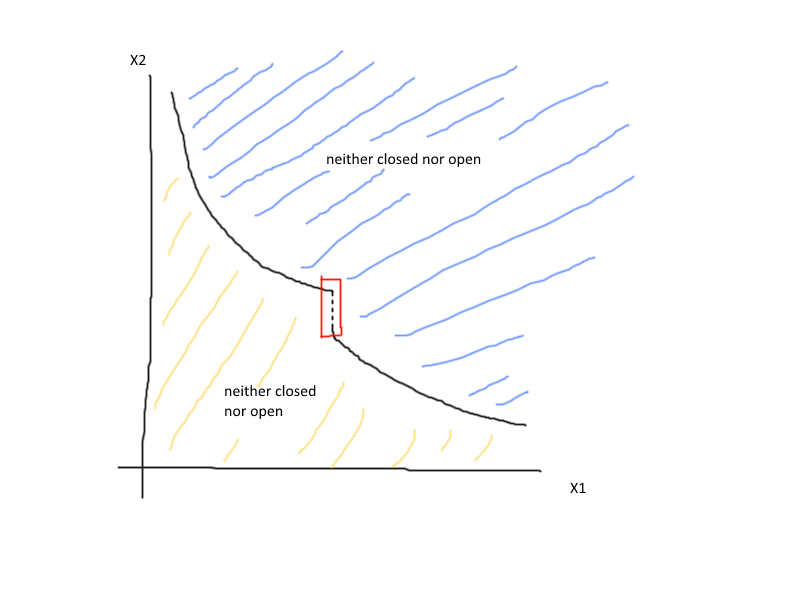[ADDED/MODIFIED] : I have put my proof where the commodity space is simply $\mathbb{R_+}$(e.g. nonnegative reals) for simplicity below. Please share your 2 cent. I have put words to aid my own understanding...
I am trying to understand that an equivalent way of stating "a preference relation that is continuous on $X$" is to say "the upper and lower contours sets are closed". What I don't understand is when MWG in Micro Book in Chapter 3 says the following :
The continuity of $\succsim$ on X implies that for any sequence of points $\{y^n\}$ with $x\succsim y^n$ $\forall n$ and $y^n$ converging to $y$, we have $x\succsim y$. And, this implies the lower contour $L(x)=\{y\in X:x\succsim y\}$ set is closed.
My questions is: how does the above statement imply the lower contour set is closed?
[New Attempt] Proof:
(1) Recall Definition 3.C.1(Modified for $\mathbb{R}$):
The preference relation $\succsim$ on $X\subset\mathbb{R_+}$ is continuous if it is preserved under limits. That is, for any sequence of pairs $\{(x^n, y^n)\}^\infty_{n=1}$ with $x^n \succsim y^n$ for all $n$, $x = \lim_{n \rightarrow \infty} x^n$, and $y = \lim_{n \rightarrow \infty} y^n$, we have $x \succsim y$.
(In words, if you have a sequence of reals $x^n$ and $y^n$ where each term in $x^n$ is greater or equal to that of in $y^n$ and $x^n\rightarrow x$, $y^n\rightarrow y$, then you have $x\succsim y$. Notice here, to facilitate understanding, I basically equated the preference relation as the in\equality on reals, thus the expression "greater or equal". An example is $x=2,y=1$. Essentially, look at the equivalence class of 2 and 1 on real line with the restriction that it is not any sequence converging to these numbers but need to narrow down to the group of convergent sequences where each term in $x^n$ is greater or equal to that of in $y^n$.)
(2) The above definition implies the following: for any sequence of pairs $\{(x^n, y^n)\}^\infty_{n=1}$ with $x\succsim y^n$ $\forall n$, where $x^n=x$ $\forall n$ with $y^n$ converging to $y$, we have $x\succsim y$.
((1) certainly implies (2), because again think of the example, $x^n=2, 2, 2, \dots$ and $y^n$ being any member of the equivalence class of 1 with the restriction each term has to be less or equal to 2. How does the set of the sequences $y^n$ satisfying this condition actually look like on the real line? Each term has to be less or equal to 2 but we are in the nonnegative commodity space $\mathbb{R_+}$, so we have a set of sequences bounded in the interval $[0,2]$ but convergent to the number 1. This example is still valid for any pair of sequences of reals $x^n\geq y^n$ where $y^n$, the sequence of reals is a bounded sequence in $[0,x]$ converging to any a point $y\in[0,x]$ while $x^n=x,x,x,\dots$, we have $x\geq y$.)
(3) Define the lower contour set to be $L(x)=\{y\in X:x\succsim y\}$. Then, (2) implies $L(x)$ is closed.
(In (2), we attained that for any pair of sequences of reals $x^n\geq y^n$ where $y^n$, the sequence of reals is a bounded sequence in $[0,x]$ converging to any a point $y\in[0,x]$ while $x^n=x,x,x,\dots$, we have $x\geq y$. The lower contour set is exactly a collection of real numbers $y$ such that it is less or equal to some $x$ on the real line. Then for any real number $y\in[0,x]$, you have a sequence of reals bounded by $0$ and $x$ where it converges to that $y$.Then, $L(x)$ contains all its limit points. Hence, it is closed.)
[Old Attempt] My instinct was to show the lower contour set is closed is equivalent to showing the set contains all its limit points. And how do you do this? Well, in this case, it is to show whether, say the lower contour set, contains its boundary points. These points in collection is just the indifference set $I(x)=\{y\in X:y\sim x\}$.
Then, I want to show $I(x)\subset L(x)$.
Proof : (1) Suppose $x\in I(x)$.
(2) By definition, $x\succsim y$ and $y\succsim x$ $\iff x\sim y$. Hence, $I(x)=\{y\in X:y\succsim x\}\cap\{y\in X:x\succsim y\}$.
(3) Hence, $x\in L(x)$ and $I(x)\subset L(x)$. Q.E.D.
Is my approach incomplete and how should I make sense of MWG's claim above? Please help. Thank you!!
